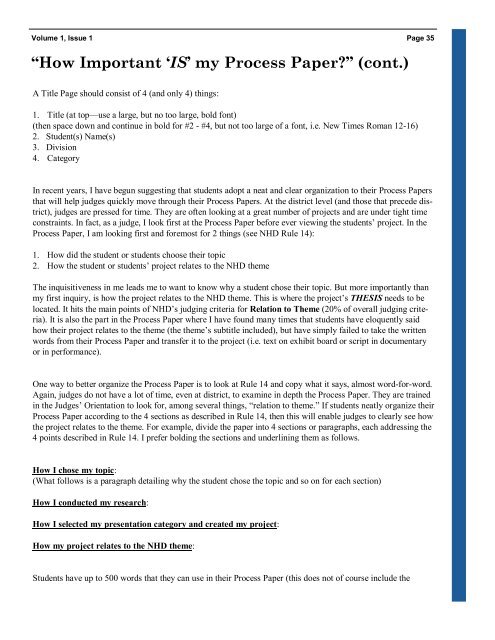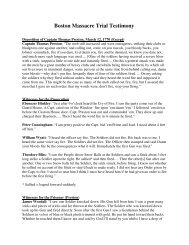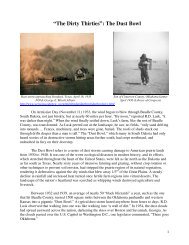Volume 1, Issue 1 - Teach American History
Volume 1, Issue 1 - Teach American History
Volume 1, Issue 1 - Teach American History
You also want an ePaper? Increase the reach of your titles
YUMPU automatically turns print PDFs into web optimized ePapers that Google loves.
<strong>Volume</strong> 1, <strong>Issue</strong> 1<br />
“How Important ‘IS’ my Process Paper?” (cont.)<br />
A Title Page should consist of 4 (and only 4) things:<br />
1. Title (at top—use a large, but no too large, bold font)<br />
(then space down and continue in bold for #2 - #4, but not too large of a font, i.e. New Times Roman 12-16)<br />
2. Student(s) Name(s)<br />
3. Division<br />
4. Category<br />
In recent years, I have begun suggesting that students adopt a neat and clear organization to their Process Papers<br />
that will help judges quickly move through their Process Papers. At the district level (and those that precede district),<br />
judges are pressed for time. They are often looking at a great number of projects and are under tight time<br />
constraints. In fact, as a judge, I look first at the Process Paper before ever viewing the students’ project. In the<br />
Process Paper, I am looking first and foremost for 2 things (see NHD Rule 14):<br />
1. How did the student or students choose their topic<br />
2. How the student or students’ project relates to the NHD theme<br />
The inquisitiveness in me leads me to want to know why a student chose their topic. But more importantly than<br />
my first inquiry, is how the project relates to the NHD theme. This is where the project’s THESIS needs to be<br />
located. It hits the main points of NHD’s judging criteria for Relation to Theme (20% of overall judging criteria).<br />
It is also the part in the Process Paper where I have found many times that students have eloquently said<br />
how their project relates to the theme (the theme’s subtitle included), but have simply failed to take the written<br />
words from their Process Paper and transfer it to the project (i.e. text on exhibit board or script in documentary<br />
or in performance).<br />
One way to better organize the Process Paper is to look at Rule 14 and copy what it says, almost word-for-word.<br />
Again, judges do not have a lot of time, even at district, to examine in depth the Process Paper. They are trained<br />
in the Judges’ Orientation to look for, among several things, “relation to theme.” If students neatly organize their<br />
Process Paper according to the 4 sections as described in Rule 14, then this will enable judges to clearly see how<br />
the project relates to the theme. For example, divide the paper into 4 sections or paragraphs, each addressing the<br />
4 points described in Rule 14. I prefer bolding the sections and underlining them as follows.<br />
How I chose my topic:<br />
(What follows is a paragraph detailing why the student chose the topic and so on for each section)<br />
How I conducted my research:<br />
How I selected my presentation category and created my project:<br />
How my project relates to the NHD theme:<br />
Students have up to 500 words that they can use in their Process Paper (this does not of course include the<br />
Page 35






